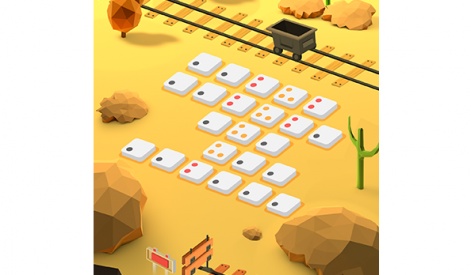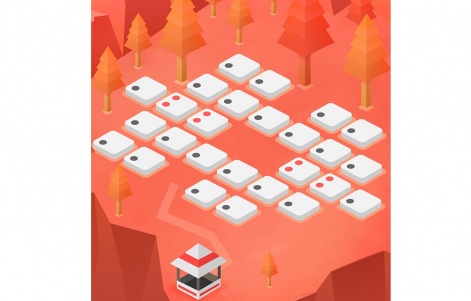An App Store feature changed the fortunes of Dropout Games' first title, UNWYND.
After gaining little traction on Android and things looking desperate, the free-to-play, Pune-developed puzzler was granted some much-needed support from Apple.
“I thought that it would just be featured in India, but then it got a worldwide feature," Dropout Games' Business Development Director Ankush Madad explained to PocketGamer.biz back in November 2015.
"Games get featured in our own region, but for an Indian game to get featured in countries like UK, US? That's very rare."
Changes everything
It was enough to change the game's fortunes but, with the benefit of hindsight, Madad told us one fundamental change he would have made.
“If you knew Apple was going to feature you, then you'd probably want to go and make it a premium game," he commented in 2015.
For the follow-up title, Blyss - launched in July 2016 - Dropout Games had the confidence to do just that, even turning down the opportunity to work with publishers by adopting a free-to-play model.
Early signs are that the risk has paid off, with Blyss enjoying a worldwide feature at launch and Editors' Choice Award in 87 countries.
And so, we ask our Indian Mavens:
- How encouraging is it to see Apple throw its weight behind a small independent studio from India?
- Apple still supports premium games, but is the model too much of a risk for most Indian studios?
First of all, I'd like to congratulate Ankush and the team at Dropout Games on their huge success and the remarkable work that must have gone into the making of Blyss. Kudos, guys!
It is extremely encouraging to see Apple support small studios as for most of us with a zero budget marketing deck, it's a make-or-break event!
While it reinforces my belief that quality products will attract all the support they need to drive them through, I find myself coming back to the question, "how much should we rely on an Apple feature?"
It's encouraging to see Apple support indies as for most of us with zero marketing budget, it's a make-or-break event.Abhineet Prasad
Premium games definitely cater to a strong enough niche segment in the market, and while most of the successful ones seem to be PC ports with an already existing fanbase, there have been a lot of mobile first stand-outs as well such as Monument Valley and countless others.
Premium games are doing well, but only a handful of them. It is definitely risky, but is it any more risky than the free-to-play ones?
The monetisation model may affect your game design, your target audience and your marketing plan, but I feel that it plays little role in your game's success.
But I am sure a lot of you will disagree and I am curious to read through this discussion to be convinced otherwise.
At the end of the day, making money from your game is a challenge as the industry is extremely competitive and quality products with the right marketing should shine through.
On a side note, I've always wanted to know the approach that studios take to market their premium games beyond an Apple feature.
There is little information available on the internet, as it seems to be abound with marketing techniques for free-to-play games and I feel that although most of the points hold true for all kinds of games, the list misses out on what specifically premium games should go for.
I would appreciate it a lot if someone could throw some light on a few of their methods.

Shailesh Prabhu is an Indie Game Designer from India who has been designing games for over ten years. Seven years ago he founded Yellow Monkey Studios and is the recipient of numerous game design and entrepreneurship awards around the world. Socioball, HUEBRIX, It’s Just a Thought are some of his recent games. Shailesh is also an excellent cook, loves playing tennis, gardening and DIY projects apart from sporting facial hair.
It's amazing that they are doing this, but they always have! I also think that a feature is way more important for a small budget paid game, than for a free game.
I think its all about expectations and the type of game you have. We need to have realistic expectations from each of our games.
A US featured game (best new games) and some banner features here and there, will typically earn $10,000 in the launch week.
Over the next month or so it will triple this figure (more or less irrespective of price point in a similar range, as a $3 game will get fewer downloads and a $2 might get slightly more, so it evens out).
The reason a lot of developers quickly conclude that paid = risky is that a lot of my interactions are met with expectations that releasing a game yields millions of dollars - and that if it doesn't, you are failing.
This, coupled with the fact that there are more million dollar stories coming in from the free-to-play side.
There is an association being formed in peoples mind with no causal relation. It's poor research to think every free game makes millions. Also, most of the free games making those numbers have huge marketing budgets.
Honestly, I feel its riskier as a small studio to make a free game.
But ultimately, it comes down to the game. If a game fits well into the freemium scheme of things, sure, but if not, a forced free-to-play game is not going to do anything in the market. I don't see the value in that.
The game should be what it needs to be. If you can push the quality and playability of the game to a level where you can stand next to global hits, you have just as much as chance of being the next Monument Valley.
It's a risk for studios everywhere, since success or failure seems to depend almost entirely on being featured.
It seems like premium games fare much worse on Android.Siddharth Sivaraman
And while Blyss proves this is very doable for Indian studios, you're still competing with a lot of good games coming out every week all over the world competing for that coveted spot on the App Store.
It also seems like premium games fare much worse on Android.
But seeing that so many featured premium iOS games are ports of PC versions, makes me wonder if it might be better to design that premium game idea you have with PC in mind.
Platforms like Steam seem somewhat more favourably disposed towards indie developers. And maybe some success on PC might help the iOS version too.
Obviously not every PC game would port well to mobile, but keeping mobile in mind from the start might make it easier.
It's always great to see Apple support small studios. They have always been featuring good Indian content globally for a while now.
This really helps sustain smaller studios who have little or no marketing budget.
The premium question really boils down to the type of content the studio is making and the sustainability it creates for running the studio.
If the studio depends on taking their games global with the help of a publisher, then the answer is a big no. Most publishers we have written to do not even want to listen to a pitch which is not freemium.
That makes self-publishing the only main route to take your paid game idea forward, which is a huge risk for smaller studios.
Getting a feature spot then becomes a very important goal for the game to get any traction.
Speaking from personal experience, Apple’s support of high quality games - irrespective of the size of the studio they come from - is extremely encouraging.
Apple's support of our previous game had a big role to play in the popularity it garnered, and it's always been far more approachable and helpful than other platforms.

I think premium games are as much risk as F2P games. I believe Apple’s support extends to high quality games, irrespective of monetisation model they may have in place.
In the end it is up to the developer to decide what is the best fit for the game they are making, and how well they can utilise it to extract the best possible revenue from their game.

Joined Robosoft Technologies in 2002 as software engineer and worked on Mac platform with focus on graphics and OpenGL. From 2006, worked on reengineering over 10 AAA PC titles to Mac and managed client coordination, internal team and product development. Since 2011, leading the productions of casual games in 99Games. Building and managing creative, development and design teams at 99Games, product conceptualisation and design, reviewing technical designs, coordinations with vendors/publishers/distributors, game release plans, marketing and monetizations.
Whether premium or freemium, love from Apple is always a great encouragement to small independent studios and an added bonus to their monetisation.
The successful monetisation of a game boils down to this basic equation: CAC (Cost of Acquiring Customer) < LTV.Shilpa Bhat
As most of us know, the successful monetisation of a game boils down to this basic equation: CAC (Cost of Acquiring Customer) < LTV (Lifetime Value of a Customer).
Given that not every game would go as viral as Flappy Bird or Pokemon GO, either the studios need to spend marketing dollars to scale the user base on their own or depend primarily on store featuring.
Freemium titles give small studios the flexibility to start with smaller marketing budgets and scale eventually if the titles exhibit good user engagement and monetisation.
As the LTV of a premium title is fixed at face price of the title, maintaining profitable LTV-CAC becomes more challenging with a premium game unless there is a greater organic user influx either from some viral aspect of the game or repeated featuring on the store.
That said, with more competitive market conditions for user acquisition, even freemium titles need to be of great quality and store featuring always comes in as bonus to balance the CAC vs LTV.
So it’s a call to be taken by the studio on what works best for them.
Going by our recent observations, Apple has a special place in its heart for indie titles. It seems to take a lot of pain in identifying good content from indies while standing up to pressure from much more established publishers and brands in the freemium space.
Credit to the team behind Blyss for being one of them.
It's definitely a risky deed for most Indian studios - if you fail to get the US App Store feature slot, you’re doomed.
Most of us don’t have the marketing budget to back unless the game is published by a western publisher.
I believe that if your game is meant for gamers to finish it before moving on to the next title, the game is worth being a premium one just like Amir’s A Dark Room and Monument Valley.

I hope Blyss makes it to that list.
Cheers to Dropout games for such a bold move and sticking to it till the end! I can see why they had self-published the game, as most western publishers prefer F2P games backed with marketing plan and budget.
This love and support from Apple will definitely boost the indie scene here.
For F2P, if the game doesn’t have enough retention numbers, it is hard to monetise.
Although the LTV for premium games is finite, controlled recurrent costs give devs the freedom to try new things.Laxmi Khanolkar
According to our experience of Scribbled Arena, we originally planned this game to be F2P. It was well appreciated but lacking in retention, so we looked at the data and tried fixing it, until we started investing our marketing fund (not so huge) into development.
Hence, we stopped the F2P efforts on Scribbled Arena, and now we are changing the game to be premium. Soon, we will launch the game on the App Store using the premium model.
Although the LTV for premium games is finite, since one doesn’t have to support it as much as you need to for F2P, controlled recurrent costs give the developer the freedom to try completely new things.
In short, the premium model is a good way to start until you come up with an awesome, addictive game with fantastic DAUs and MAUs.
Blyss being featured was definitely very encouraging and significant, especially since my next game BLUK launches in a week on the App Store.
Dropout Games did everything right and focused on sticking to the core idea, what the game stands for. So congrats to them for that.
Apple's love for well-polished indie games that bring something unique to the table still seems to be strong.
This is exciting as there seem to be many that meet this criteria coming from India, as seen at the last Pocket Gamer Connects Bangalore.
Using the premium model for games is way too much of a risk if you are targeting the Indian audience.
But globally, I think the premium model is still a way to go if you don't have a lot of marketing money and especially if you are small studio without a marketing god as part of the team.
I say think of traditional video games and make a game that is polished and feature-rich to be a premium game before deciding the right model - unless you know that you have made the next Flappy Bird.
A feature could either be deemed successful, or at least expose other channels for the studio to explore if interested.
With that said, I myself will have to wait and see how well this model works out, as I too have chosen the premium path for BLUK.
Thank you for highlighting the game!
The decision to go premium was a well thought-out decision. A lot of factors were put into consideration and it resonated well with our iOS expansion strategy.
A lot of people above have mentioned that it has a lot to do with the kind of game. In Blyss' case, the gameplay is equally suitable to both categories.

For us, It had more to do with our internal strategy. Things would be different for Android, though. We've been approached by multiple publishers for Android and are discussing things currently.
During my visit to GDC in San Francisco, I met several other indies from different parts of the world and their response was very similar when it came to Apple's attitude towards indies.
I think it has less to do with the country and more to do with the quality of your game and popularity it gets pre-release. This constant support from Apple is a good sign.
Premium is straight-up revenue. You have a smaller audience to cater to. It's a win-win for smaller studios.Ankush Madad
However, getting featured is more of a stepping stone towards the actual success.
I think if the game is good enough, premium is a much better model for studios that have smaller teams and smaller budgets.
It's straight-up revenue for your game. You have a smaller audience to cater to. It's a win-win for smaller studios like us.
Also, the exposure an Indian developer gets on Apple and the exposure their western indie counterparts of equal size get is the same, but the cost of production in India is much lesser than the others and that's where the advantage lies for Indian developers.
I saw Deepak's game BLUK, and feel sure that it's bound to get a similar kind of response from Apple that Blyss got.
If other smaller devs from India can also step up their development game, not chase after proven formulae, come up with something original/innovative and polish it to the maximum, then I'm confident that Apple will definitely support them.
I hope to see more games get Apple's support and eventually become global hits.

























